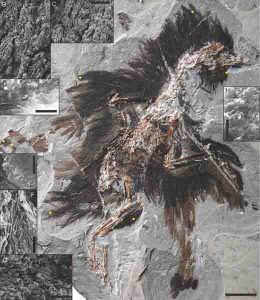
In a new paper published in National Science Review, a team of scientists from the Institute of Vertebrate Paleontology and Paleoanthropology, the Shandong Tianyu Museum of Nature, and the Nanjing Institute of Geology and Paleontology (all in China) described the most exceptionally preserved fossil bird discovered to date.
The new specimen from the rich Early Cretaceous Jehol Biota (approximately 131 to 120 million years old) is referred to as Eoconfuciusornis, the oldest and most primitive member of the Confuciusornithiformes, a group of early birds characterized by the first occurrence of an avian beak. Its younger relative Confuciusornis is known from thousands of specimens but this is only the second specimen of Eoconfuciusornis found. This species comes only from the 130.7 Ma Huajiying Formation deposits in Hebei, which preserves the second oldest known fossil birds. Birds from this layer are very rare.
This new specimen of Eoconfuciusornis, housed in the Shandong Tianyu Museum of Nature, in Eastern China, is a female. The ovary reveals developing yolks that vary in size, similar to living birds. This suggests that confuciusornithiforms evolved a period of rapid yolk deposition prior to egg-laying (crocodilians, which are archosaurs like birds, deposit yolks slowly in all eggs for months with no period of rapid yolk formation), which is indicative of complex energetic profiles similar to those observed in birds.
This means Eoconfuciusornis and its kin, like living birds, was able to cope with extremely high metabolic demands during early growth and reproduction (whereas energetic demands in crocodiles are even, lacking complexity). In contrast, other Cretaceous birds including the more advanced group the Enantiornithes appear to have lower metabolic rates and have required less energy similar to crocodilians and non-avian dinosaurs (their developing yolks show little size disparity indicating no strong peak in energy associated with reproduction, and much simpler energetic profiles, limited by simpler physiologies).
Traces of skin indicate that the wing was supplemented by flaps of skin called patagia. Living birds have numerous wing patagia that help the bird to fly. This fossil helps show how bird wings evolved. The propatagium (the flap of skin that connects the shoulder and wrist) and postpatagium (the flap of skin that extends off the back of the hand and ulna) evolved before the alular patagium (the flap of skin connecting the first digit to the rest of the hand), which is absent in Eoconfuciusornis. Even more unique is the preservation of the internal structure of the propatagium which reveal a collagenous network identical to that in living birds. This internal network gives the skin flap its shape, allowing it to generate aerodynamic lift and aid the bird in flight.
The nearly complete plumage preserves remnants of the original plumage pattern, revealing the presence of spots on the wings and the earliest documentation of sexual differences in plumage within birds. This new specimen suggests that female Eoconfuciusornis were smaller than males and lacked tail feathers, similar to many sexually dimorphic living birds and the younger Confuciusornis in which the plumage of the males and females are different from each other. Samples of the feathers viewed under a microscope reveal differences in color characteristics, allowing scientists to reconstruct the plumage. Female Eoconfuciusornis had black spotted wings and gray body with a red throat patch.
Researchers have not found fossils from any other bird from the Jehol period that reveal so many types of soft tissue (feathers, skin, collagen, ovarian follicles). These remains allow researchers to create the most accurate reconstruction of a primitive early bird (or dinosaur) to date. This information provides better understanding of flight function in the primitive confuciusornithiforms and of the evolution of advanced flight features within birds.
“This new fossil is incredible,” said co-author Dr. Jingmai O’Connor. “With the amount of information we can glean from this specimen we can really bring this ancient species to life. We can understand how it grew, flew, reproduced, and what it looked like. Fossils like this one from the Jehol Biota continue to revolutionize our understanding of early birds.”
Reference:
Xiaoting Zheng, Jingmai K. O’Connor, Xiaoli Wang, Yanhong Pan, Yan Wang, Min Wang, Zhonghe Zhou. Exceptional preservation of soft tissue in a new specimen of Eoconfuciusornis and its biological implications. National Science Review, 2017; DOI: 10.1093/nsr/nwx004
Note: The above post is reprinted from materials provided by Oxford University Press USA.










